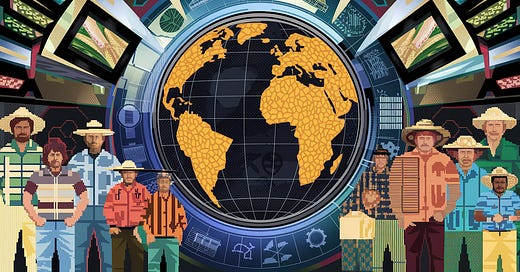🌽 Tariffs and Tribulations: How Trump's Policies Affect Our Farmers
Discover how political decisions turn American fields into battlefields, impacting farmers' livelihoods.
😽 Keepin’ It Simple Summary for Younger Readers
👧🏾✊🏾👦🏾
🎮 Imagine a giant game where people from different countries trade things with each other, like how we swap toys. 🌍🤝 When leaders decide to make it harder to trade, by setting rules called tariffs, it can make it tough for farmers 🌽👨🌾 to sell things like soybeans and beef 🐄🥩 to other countries. This means they might struggle to earn money 💸, and the food we usually buy might cost more. It's like playing a game where the rules suddenly change, making it harder for some players to win. 🏆🔄
🗝️ Takeaways
🌽 Tariff Terror: U.S. agricultural communities are significantly affected by economic policies.
🐄 Beef Woes: Tariffs can make essential food items like beef more expensive for consumers.
📉 Market Mayhem: Trade strategies lead to global market disruptions and export losses.
⚠️ Intersectional Impact: Tariffs disproportionately affect indigenous, Chicano, and immigrant laborers.
✊ Join the Fight: Supporting local farmers and advocating for fair trade can help counteract negative impacts.
Tariff Terror: How Agricultural Communities Are Bleeding for Political Showmanship
Nepantla: Caught Between Survival and Systemic Violence
¡Órale, let me tell you a story of economic violence that cuts deeper than any border wall. The landscape of American agriculture isn't just a field of crops—it's a battlefield where political egos wage war against the very people who feed this nation.
When we talk about tariffs, we're not discussing abstract economic policy. We're talking about the lifeblood of communities, the sweat of farmers who rise before dawn, the generations of knowledge embedded in every handful of soil.
Trump's tariff strategy is like a colonial bulldozer, crushing the dreams and livelihoods of agricultural workers with the same destructive force that has historically trampled indigenous lands. It's a systematic assault that goes far beyond simple economic policy—it's economic warfare against the heart of rural America.
The First Round: Tariff Trauma of 2018-2020
The first wave of Trump's trade war wasn't just an economic policy—it was an economic massacre that left agricultural communities bleeding and bewildered.
Imagine watching your life's work, your family's generational investment in the land, become collateral damage in a political chess game played by suits who've never gotten dirt under their fingernails.
Key devastation from the first tariff offensive:
$27 billion in agricultural export losses
Soybeans were decimated by 71% of total export reductions
Entire states like Iowa, Illinois, and Kansas watching their agricultural economies bleed out
$16 billion total trade losses
The numbers are staggering, but they don't capture the human cost. ¿Qué chingados? This wasn't protection. This was economic terrorism that targeted the most vulnerable agricultural workers.
The Beef with Beef: Rising Prices and Broken Promises
Let's talk about meat—a critical component of this economic nightmare that hits every American right in the grocery cart. The United States relies heavily on importing lean beef from Canada and Mexico to mix with fattier domestic beef. These new tariffs are about to turn your hamburger into a luxury item.
Imagínate—the price of ground beef could spike dramatically in just six to eight weeks, creating a ripple effect that touches every dinner table from the Rio Grande to the Canadian border.
Livestock producers are caught in a brutal trap. They'll see some relief as feed costs decline, but the overall economic impact is devastating. Specialty cuts like beef tongue—almost entirely exported—will see prices plummet. It's a lose-lose scenario that demonstrates the profound disconnect between political posturing and agricultural reality.
Trump's Second Act: The 2025 Tariff Offensive
Now we're witnessing a horror sequel that nobody asked for. Trump returns like a economic vampire, ready to drain the life from agricultural communities once again.
The new tariff landscape is a minefield of potential destruction, threatening to repeat—and potentially exceed—the economic devastation of his first term.
Key impacts of the new tariffs:
Corn and soybean prices plummeting by 10%
Fertilizer costs skyrocketing
Potential billions in agricultural export losses
Disrupted global trade relationships
The Intersectional Brutality of Trade Policies
This isn't just about economics. It's a multilayered system of oppression that targets the most vulnerable:
Colonial systems continuing to extract from indigenous and agricultural communities
Environmental justice being sacrificed for political performance
Communities of color bearing the heaviest economic burdens
Agricultural workers—many of whom are indigenous, Chicano, and immigrant laborers—are the first and most brutal casualties of these policies. Nos están matando con papel—they're killing us with paperwork, with policies, with a system designed to extract and destroy.
Personal Resistance: Solidarity in the Struggle
Mis compañeros, we cannot let this continue. These tariffs are more than economic policy—they're a continuation of ongoing colonial violence against agricultural communities, especially Indigenous and Chicano farmers who have stewarded this land for generations.
How the Tariffs Actually Work (In Human Terms)
Global Market Disruption: Countries like China, Mexico, and Canada retaliate with their own tariffs
Export Markets Collapse: U.S. farmers lose critical international buyers
Domestic Prices Fluctuate: Consumers see unpredictable food pricing
Long-Term Investment Discouraged: Farmers hesitate to invest in future production
A Note of Hope and Resistance
La lucha continúa. But we are not defeated. We are resilient. We are powerful.
How You Can Fight Back:
Support local farmers' markets
Amplify indigenous agricultural voices
Pressure congressional representatives
Join agricultural and trade policy advocacy groups
Learn about food sovereignty movements
Call to Action
Comunidad, this is our moment. These policies don't define us—our collective resistance does.
I want to hear from YOU:
How have these tariffs impacted your community's agricultural workers?
What strategies of resistance have you seen working on the ground?
Drop your thoughts in the comments. Juntos somos más fuertes - Together we are stronger.
Con respeto y resistencia,
Your Borderlands Blogger






